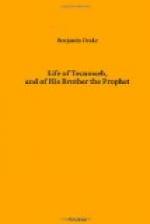with Indians, being such as to prevent the wings from
being turned, general Harrison made arrangements to
concentrate his forces against the British line.
The first division, under major general Henry, was
formed in three lines at one hundred yards from each
other; the front line consisting of Trotter’s
brigade, the second of Chiles’, and the reserve
of King’s brigade. These lines were in
front of, and parallel to, the British troops.
The second division, under major general Desha, composed
of Allen’s and Caldwell’s brigades, was
formed
en potence, or at right angles to the
first division. Governor Shelby, as senior major
general of the Kentucky troops, was posted at this
crotchet, formed between the first and second divisions.
Colonel Simrall’s regiment of light infantry
was formed in reserve, obliquely to the first division,
and covering the rear of the front division; and,
after much reflection as to the disposition to be
made of colonel Johnson’s mounted troops, they
were directed, as soon as the front line advanced,
to take ground to the left, and forming upon that
flank, to endeavor to turn the right of the Indians.
A detachment of regular troops, of the 26th United
States infantry, under colonel Paul, occupied the
space between the road and the river, for the purpose
of seizing the enemy’s artillery; and, simultaneously
with this movement, forty friendly Indians were to
pass under the bank of the stream to the rear of the
British line, and by their fire and war-cry, induce
the enemy to think their own Indians were turning
against them. At the same time, colonel Wood had
been instructed to make preparations for using the
enemy’s artillery, and to rake their own line
by a flank fire. By refusing the left or second
division, the Indians were kept
in the air,
that is, in a position in which they would be useless.
It will be seen, as the commander anticipated, that
they waited in their position the advance of the second
division, while the British left was contending with
the American right. Johnson’s corps consisted
of nine hundred men, and the five brigades under governor
Shelby amounted to near eighteen hundred, in all,
not exceeding two thousand seven hundred men.
In the midst of these arrangements, and just as the
order was about to be given to the front line to advance,
at the head of which general Harrison had placed himself
with his staff, colonel Wood approached him with intelligence,
that having reconnoitered the enemy, he had ascertained
the singular fact, that the British lines, instead
of the usual close order, were drawn up at open
order. This fact at once induced general
Harrison to adopt the novel expedient of charging the
British lines with Johnson’s mounted regiment.
“I was within a few feet of him,” says
the gallant colonel John O’Fallon, “when
the report of colonel Wood was made, and he instantly
remarked, that he would make a novel movement by ordering
colonel Johnson’s mounted regiment to charge




